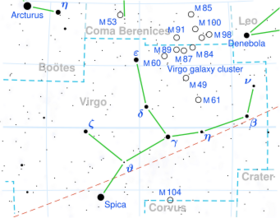Astronomy:Tau Virginis
| Observation data Equinox J2000.0]] (ICRS) | |
|---|---|
| Constellation | Virgo |
| Right ascension | 14h 01m 38.79341s[1] |
| Declination | +01° 32′ 40.3145″[1] |
| Apparent magnitude (V) | 4.2777±0.0007[2] |
| Characteristics | |
| Spectral type | A2IV/V[3] |
| U−B color index | +0.12[4] |
| B−V color index | +0.11[4] |
| Astrometry | |
| Radial velocity (Rv) | −6.7±0.9[5] km/s |
| Proper motion (μ) | RA: +17.49[1] mas/yr Dec.: −21.27[1] mas/yr |
| Parallax (π) | 14.50 ± 0.18[1] mas |
| Distance | 225 ± 3 ly (69.0 ± 0.9 pc) |
| Absolute magnitude (MV) | +0.5[6] |
| Details | |
| Mass | 1.96[7] M☉ |
| Radius | 1.6[8] R☉ |
| Luminosity | 70[9] L☉ |
| Surface gravity (log g) | 3.39[7] cgs |
| Temperature | 8,413±286[7] K |
| Metallicity [Fe/H] | −0.19[10] dex |
| Rotational velocity (v sin i) | 186[11] km/s |
| Age | 724[7] Myr |
| Other designations | |
| Database references | |
| SIMBAD | data |
Tau Virginis (τ Vir, τ Virginis) is a single[13] star in the zodiac constellation Virgo. With an apparent visual magnitude of 4.28,[2] it is faintly visible to the naked eye. The distance to Tau Virginis, based upon parallax measurements, is approximately 225 light years with a margin of error of ±3 light years.
This star has a stellar classification of A2IV/V,[3] which matches the spectrum of an A-type main sequence star mixed with spectral traits of a subgiant. It is about 700[7] million years old and is spinning rapidly with a projected rotational velocity of 186 km/s.[11] The star has nearly double[7] the mass of the Sun and about 160% of the Sun's radius.[8] It shines with 70[9] times the luminosity of the Sun and has an effective temperature of 8413 K in its outer atmosphere.[7]
Tau Virginis has multiple visual companions, listed below:[14]
| Companion | Visual Magnitude |
Angular Separation |
Position Angle |
Year Measured |
|---|---|---|---|---|
| B | 9.41 | 82.70″ | 287° | 2012 |
| C | 13.10 | 176.70″ | 353° | 2000 |
| D | 9.68 | 342.70″ | 85° | 2012 |
| E | 12.00 | 14.6″ | 175° | 2009 |
References
- ↑ 1.0 1.1 1.2 1.3 1.4 van Leeuwen, F. (November 2007), "Validation of the new Hipparcos reduction", Astronomy and Astrophysics 474 (2): 653–664, doi:10.1051/0004-6361:20078357, Bibcode: 2007A&A...474..653V.
- ↑ 2.0 2.1 Adelman, S. J. (February 2001). "Research Note Hipparcos photometry: The least variable stars". Astronomy and Astrophysics 367 (1): 297–298. doi:10.1051/0004-6361:20000567. Bibcode: 2001A&A...367..297A.
- ↑ 3.0 3.1 Houk, N.; Swift, C. (1999), "Michigan catalogue of two-dimensional spectral types for the HD Stars, Vol. 5", Michigan Spectral Survey 05, Bibcode: 1999MSS...C05....0H
- ↑ 4.0 4.1 Mermilliod, J.-C. (1986), "Compilation of Eggen's UBV data, transformed to UBV (unpublished)", Catalogue of Eggen's UBV Data (SIMBAD), Bibcode: 1986EgUBV........0M
- ↑ Gontcharov, G. A. (2006), "Pulkovo Compilation of Radial Velocities for 35 495 Hipparcos stars in a common system", Astronomy Letters 32 (11): 759–771, doi:10.1134/S1063773706110065, Bibcode: 2006AstL...32..759G.
- ↑ Blondel, P. F. C.; Djie, H. R. E. Tjin A. (September 2006), "Modeling of PMS Ae/Fe stars using UV spectra", Astronomy and Astrophysics 456 (3): 1045–1068, doi:10.1051/0004-6361:20040269, Bibcode: 2006A&A...456.1045B, https://pure.uva.nl/ws/files/2215853/46569_211516y.pdf.
- ↑ 7.0 7.1 7.2 7.3 7.4 7.5 7.6 David, Trevor J.; Hillenbrand, Lynne A. (2015), "The Ages of Early-Type Stars: Strömgren Photometric Methods Calibrated, Validated, Tested, and Applied to Hosts and Prospective Hosts of Directly Imaged Exoplanets", The Astrophysical Journal 804 (2): 146, doi:10.1088/0004-637X/804/2/146, Bibcode: 2015ApJ...804..146D.
- ↑ 8.0 8.1 Pasinetti Fracassini, L. E. et al. (February 2001), "Catalogue of Apparent Diameters and Absolute Radii of Stars (CADARS) - Third edition - Comments and statistics", Astronomy and Astrophysics 367 (2): 521–524, doi:10.1051/0004-6361:20000451, Bibcode: 2001A&A...367..521P.
- ↑ 9.0 9.1 McDonald, I. et al. (2012), "Fundamental Parameters and Infrared Excesses of Hipparcos Stars", Monthly Notices of the Royal Astronomical Society 427 (1): 343–57, doi:10.1111/j.1365-2966.2012.21873.x, Bibcode: 2012MNRAS.427..343M.
- ↑ Morossi, C. et al. (September 2002), "Metallicity Determinations from Ultraviolet-Visual Spectrophotometry. I. The Test Sample", The Astrophysical Journal 577 (1): 377–388, doi:10.1086/342144, Bibcode: 2002ApJ...577..377M.
- ↑ 11.0 11.1 Royer, F. et al. (February 2007), "Rotational velocities of A-type stars. III. Velocity distributions", Astronomy and Astrophysics 463 (2): 671–682, doi:10.1051/0004-6361:20065224, Bibcode: 2007A&A...463..671R.
- ↑ "* tau Vir". SIMBAD. Centre de données astronomiques de Strasbourg. http://simbad.u-strasbg.fr/simbad/sim-basic?Ident=%2A+tau+Vir.
- ↑ Eggleton, P. P.; Tokovinin, A. A. (September 2008), "A catalogue of multiplicity among bright stellar systems", Monthly Notices of the Royal Astronomical Society 389 (2): 869–879, doi:10.1111/j.1365-2966.2008.13596.x, Bibcode: 2008MNRAS.389..869E.
- ↑ Mason, B. D. et al. (2014), "The Washington Visual Double Star Catalog", The Astronomical Journal 122 (6): 3466–3471, doi:10.1086/323920, Bibcode: 2001AJ....122.3466M, http://vizier.u-strasbg.fr/viz-bin/VizieR?-source=B/wds, retrieved 2015-07-22.
 |


